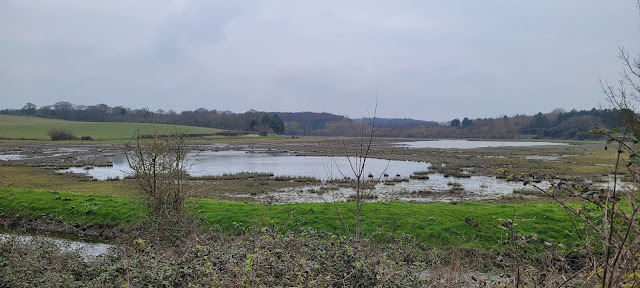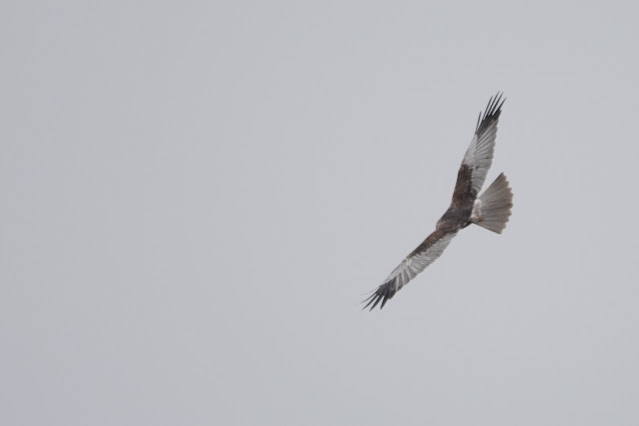Tomorrow I head west for Oriole Birding for the Forest of Dean – Somerset tour which left me having to be in Norfolk this evening. As such I began my journey from Lowestoft early and a fortuitous WhatsApp message had me re-evaluating my plan and heading towards Fakenham where Ashley had found a male Rustic Bunting in a wild bird cover crop near Broomsthorpe. It took a little over an hour to get there and I joined a small crowd on this rural roadside to scan the hedges along the field margins in the hope that it would appear from the crop and alight in view. The number of birds using the crop was fantastic and harked back to winter fields that many of us grew up with. I reckon that there were at least 60 Yellowhammer and 30 Reed Bunting along with many Chaffinch and a few Goldfinch, Greenfinch, Linnet and House Sparrows.
There was also a 30 strong Redpoll flock that at least had
the decency to feed at the top of the crops. I think just over half were
Lessers along with a dozen Mealies some of which were striking and very coldly
coloured while one male was incredibly red on the front. However I also picked
up a snow ball of a Redpoll amongst them and saw it well several times. It had clean white undertail coverts, glowing
white wing bars, a white rump and tiny bill.
It too had a pink flush on the upper breast suggesting an adult male. It
felt like a Coues’s Arctic Redpoll. I
mentioned it to several people and was pleased that Ash had also thought that
there was a good candidate out there.
 |
| Redpolls |
His diligence paid off later as he was able to confirm our suspicions that we had a three Redpoll flock. And so back to the Rustic Bunting which, after an hour decided to pop up on top of the tall trees for a couple of minutes allowing everyone to get onto it. It was a well marked bird with a big flared supercilium, rich breast band and two broad white wing bars as well as the obligatory punky crest.

Rustic Bunting - Ashley Saunders
The light
was grim and with the bird and his friends in the bag I headed north to
Stiffkey passing 100s of Fieldfares and Redwings and hanging Red Kites and Buzzards on the way.
A short walk down the A149 footpath soon put me onto the
Glossy Ibis as it probed around the flooded meadows with nine Little Egrets, a
Great White Egret, all the usual dabblers including some pinky flushed Pintail,
Black-tailed Godwits, Snipe, Ruff, Lapwings, Curlews and Redshanks.
 |
| Glossy Ibis |
I was now clock watching but calculated that I had time to visit
Blakeney for the chance of the Red-breasted Goose and was soon yomping down the
seawall from the harbour. The Dark-bellied Brents were soon visible but the
wind was now howling straight into my face but my persistence paid off and I soon
found the first-winter bird playing hide and seek amongst his darker cousins.
 |
| Red-breasted Goose |
Much closer views than the other week but equally
pleasing. Its ability to disappear
amongst the grass was infuriating but made it all the more pleasing when its
black, white and red head popped into view.
 |
| Red-breasted Goose |
 |
| Dark-bellied Brents |
A beautiful pale male Marsh Harrier put on a dazzling show and a Great White Egret flew off towards Cley where more Brents were feeding while the usual assortment of waders were out on the tidal creeks.
 |
| Marsh Harrier |
 |
| Great White Egret |
I did not linger too long and made my way
back through Stiffkey to Garden Drove for a two hour session overlooking the
very grey and colourless saltmarsh.
The Hen Harrier action was some of the best I have had in
years with a sub-adult male putting in several prolonged appearances and
covering a vast amount of ground. Two females and ringtail male were also
seen. The latter was a really dinky one
and quite educational. It did not fly
like the adult and stayed lower and incorporated several accipiter-like little
flicks into its level flight which is something I tend to look for in
Pallid. There is always something to
learn.
 |
| male Hen Harrier |
The immature female Pallid eventually came in from the west and
put on a superb performance, conducting a big circuit that brought it right in
close to us and then over the hedge and into the fields beyond, from where it
reappeared ten minutes later. She felt a shade pale underneath that when I last
saw her in early December.
 |
| Pallid Harrier |
Brent Geese grumbled their way towards Wells and parties of
Little Egrets drifted east while Merlin, Marsh Harrier, Buzzard and Red Kite
were also seen out hunting the marshes.
Two Spoonbills were feeding in a creek and they too moved off east as
the light faded and as I walked back I could hear both Grey and Red-legged
Partridges in the spent beet fields where Brown Hares lolloped with pied ear tips standing out in the gloom.
 |
| Spoonbills |
Quite a day in the field. Now only a good night’s sleep between me and journey to the Forest of Dean in the morning.





No comments:
Post a Comment